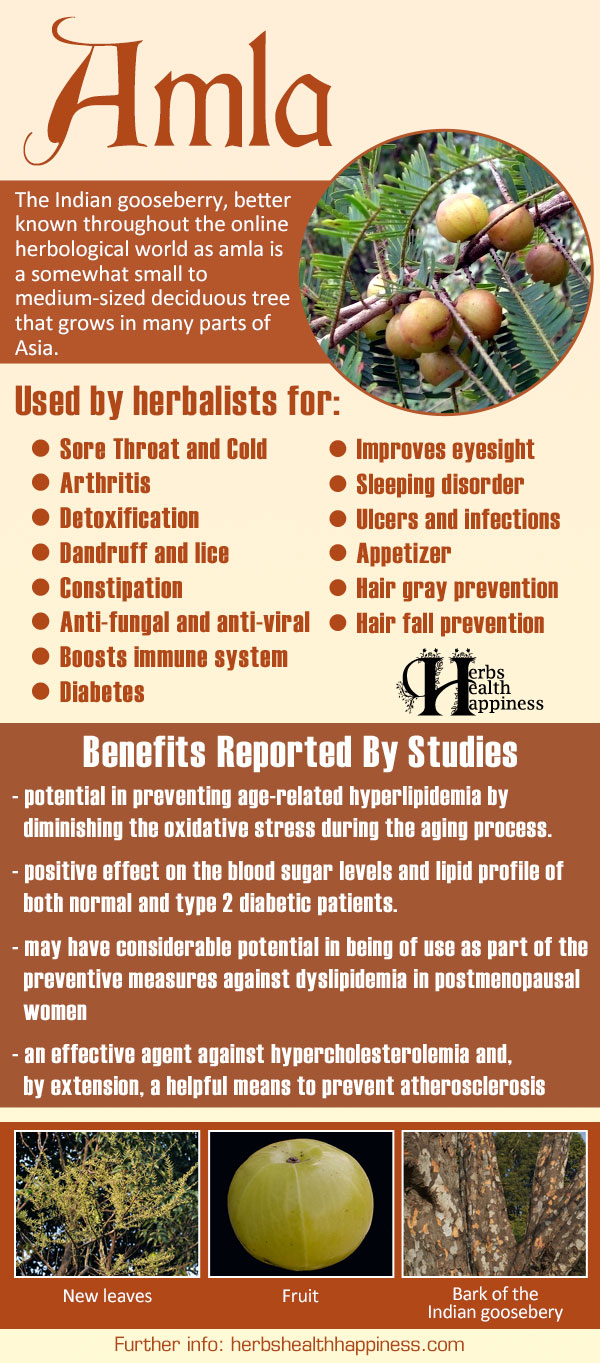Amla

Amla - Uses and Benefits
Infographic: herbshealthhappiness.com. Photo credits: See foot of article

Amla - Botany And History
The Indian gooseberry, better known throughout the online herbological world as amla is a somewhat small to medium-sized deciduous tree that grows in many parts of Asia. Belonging to the family Phyllanthaceae and known for the sour, edible light-green to yellowish-green fruit of the same name, it has long been used as both a foodstuff and medicine since ancient times. The amla tree is known to grown in many parts of Asia, but is most common in India and China, where the fruit is used as both food and medicine. Areas such as Tibet, Malaysia, Myanmar, and Indonesia also have a history of amla use, but these pale in comparison to the use the fruit and tree has had in Indian herbal medicine or Ayurveda.
Amla - Herbal Uses
The amla tree has many uses, and while it is the fruit which is most commonly prepared as a type of medicine for cosmetic purposes, the bark, leaves, and even the roots of the amla tree have been used as medicine in the traditional context as well. While modern medicine still does not credit any reliability to the efficiency of herbal extracts or traditional medicines, experimental studies have been conducted on the preparation of amla bark, leaves, and roots which has yielded the potential efficiency of the herbal preparations against certain kinds of cancers and inflammatory diseases. [1]
While the usefulness of the bark, roots, and leaves of the amla tree possess probable medical wonders that have only begun to be tapped, it is the amla fruit itself which has been used since time immemorial for a number of culinary and therapeutic purposes. Known to contain high amounts of vitamin C, with the added benefits of being surrounded by tannins which protect the delicate vitamin compound from being destroyed by heat, it is commonly consumed as an appetizer or as a form of dessert in many parts of India, where it is mixed with turmeric and salt, or otherwise steeped in a sugar or jaggery (raw sugarcane) solution to counteract its astringency. The fruit of the amla has also been used traditionally as an anti-microbial agent. Fresh, pounded fruits have been used traditionally as a remedy against dandruff and lice due to its astringent, anti-fungal, and anti-viral properties. [2] The concoction is usually mixed with honey for added benefits. Due to its high ellagitannin and antioxidant content, the amla fruit has also been used to help prevent graying hairs and hair fall in many traditional Ayurvedic remedies. [3]
The primary uses of the fresh amla fruit veer towards the traditional cosmetology and culinary medicines of India. The fruit of the amla tree is a common ingredient in the ancient medicinal jam or spread known as Chyawanprash, where it is mixed with a host of other traditional Ayurvedic herbs. [4] Amla fruit may also be dried, wherein it becomes an additive to hair-oils where it is left to steep and infuse, usually via the cold-infusion method. The most common amla hair oils are concoctions made from dried amla fruits suspended in virgin coconut oil, almond oil, or sesame oil. Traditional Indian medicine credits the use of amla oil to lush, strong, vibrant, shiny hair – a fact still commonly employed by the modern cosmetic world that now incorporate traditional beauty remedies in their products. China, which has its fair share of uses for the amla fruit (which they call yuganzi) employs the consumption of the fruit as a remedy for sore throats.
Dried amla fruits can also be mixed with henna powder to add to the 'dyeing efficiency' of the herb. Because of its high antioxidant content, dried powdered amla fruits have also been made into teas or capsules, [5] although such products are usually only available locally and have no approved therapeutic benefits save those within the immediate body of traditional Ayurvedic medicine.
Amla - Esoteric Uses
In the folklore of India, the amla fruit is meant to symbolize prosperity as many stories relate about how giving amla to a person could increase one's luck to elicit the favour of the gods. The amla fruit is sacred to the goddess Lakshmi, and Indian mythology credits the amla as the 'world tree'.
Amla - Scientific Studies
In 2007, Yokozawa et al. ventured on a study to investigate the effects of amla, or Indian gooseberry (Emblica officinalis), on the metabolism of lipid and expression of protein during oxidative stress associated with aging process. In the study, ethyl acetate extracts of amla were introduced to both young 2-month-old rats and aged 10-month-old rats for 100 days, and lipid levels were closely monitored. Results showed that amla administration significantly decreased lipid levels but increased the hepatic peroxisome proliferator-activated receptor (PPAR)-alpha protein level. [6] PPAR is a transcription factor that regulates the metabolism of lipid in the liver. [7, 8] Moreover, amla administration also decreased the levels of iNOS and COX-2 expression in aged rats, possibly by inhibiting the activation of NF-χB, a DNA transcription controller. [6] It should be noted that iNOS is involved in immune response against pathogens, [9] while COX-2 converts arachidonic acid to prostaglandin endoperoxide H2 and is therefore involved in the inflammatory response. [10] Yokozawa et al. (2007) concluded that these results suggest amla’s potential in preventing age-related hyperlipidemia by diminishing the oxidative stress during the aging process. [6]
In a more recent study by Akhtar et al. (2011), the antihyperglycemic and lipid-lowering properties of amla have also been demonstrated wherein both normal and diabetic study participants administered with 2–3 g of amla powder manifested improved high-density lipoprotein (HDL) levels and lowered low-density lipoprotein (LDL) levels. [11] HDL is considered the “good cholesterol” since it eliminates the bad cholesterol as it cruises in the bloodstream. [12] On the other hand, LDL is the “bad cholesterol” because it results in the formation of atherosclerosis and increases one’s risk of having a myocardial infarction (or heart attack). [13] The results of the study revealed a significant decrease in fasting and 2-hour postprandial blood glucose levels at p<0.05 and in total cholesterol and triglyceride levels at p<0.05 on the 21st day in both normal and diabetic study participants. [11] This study therefore reveals amla’s positive effect on the blood sugar levels and lipid profile of both normal and type 2 diabetic patients.

In 2012, an evaluative study of Koshy, Bobby, Hariharan, and Gopalakrishna declared that an amla extract is effective in preventing insulin resistance induced by a high-fructose diet in ovariectomized 3-month-old female albino rats. In this study, amla was also evaluated for its hypolipidemic properties: results showed a decrease in LDL cholesterol levels and an increase in HDL cholesterol levels in ovariectomized rats fed with chow or fructose. Because of these effects, the study concluded that amla may have considerable potential in being of use as part of the preventive measures against dyslipidemia in postmenopausal women. [14]
The 2012 evaluative study of Koshy, Bobby, Hariharan, and Gopalakrishna can be further supported by the earlier scientific investigation done by Kim et al. (2005) where the effects of amla on LDL oxidation and cholesterol level were also studied in vitro and in vivo. The administration of SunAmla or ethyl acetate (EtOAc) extract of amla led to a consequent dose-dependent reduction in total, free, and LDL-cholesterol levels. The results of this study are suggestive of amla being an effective agent against hypercholesterolemia and, by extension, a helpful means to prevent atherosclerosis. [15]
Other names for Amla, Past or Present
Hindi: aamla
Sanskrit: amalika
Chinese: yuganzi
English: Indian gooseberry
Latin (scientific nomenclature): Phyllanthus emblica; also Emblica officinalis
References:
[1] https://www.liebertonline.com/doi/abs/10.1089/jmf.2005.8.362
[2] https://articles.timesofindia.indiatimes.com/2011-02-14/beauty/28214791_1_amla-blood-sugar-hair-loss
[3] https://www.knowledgebase-script.com/demo/article-1040.html
[4] https://en.wikipedia.org/wiki/Chyawanprash
[5] https://www.ncbi.nlm.nih.gov/pubmed/17715896
[6] Yokozawa T., Kim H.Y., Kim H.J., Okubo T., Chu D.C., & Juneja L.R. (2007). Amla (Emblica officinalis Gaertn.) prevents dyslipidaemia and oxidative stress in the ageing process. British Journal of Nutrition, 97(6): 1187–1195. Retrieved February 13, 2013, from https://www.ncbi.nlm.nih.gov/pubmed/17506915
[7] Peroxisome proliferator-activated receptor alpha. Retrieved February 13, 2013, from https://en.wikipedia.org/wiki/Peroxisome_proliferator-activated_receptor_alpha
[8] PPAR alpha protein (His tag) (ab82045). Retrieved February 13, 2013, from https://www.abcam.com/PPAR-alpha-protein-His-tag-ab82045.html
[9] Nitric oxide synthase. Retrieved February 13, 2013, from https://en.wikipedia.org/wiki/Nitric_oxide_synthase
[10] Prostaglandin-endoperoxide synthase 2. Retrieved February 13, 2013, from https://en.wikipedia.org/wiki/Prostaglandin-endoperoxide_synthase_2
[11] Akhtar M.S., Ramzan A., Ali A., & Ahmad M. (2011). Effect of amla fruit (Emblica officinalis Gaertn.) on blood glucose and lipid profile of normal subjects and type 2 diabetic patients. International Journal of Food Sciences and Nutrition, 62(6): 609–616. doi: 10.3109/09637486.2011.560565. Retrieved February 13, 2013, from https://www.ncbi.nlm.nih.gov/pubmed/21495900
[12] HDL Cholesterol: The Good Cholesterol. Retrieved February 13, 2013, from https://www.webmd.com/cholesterol-management/hdl-cholesterol-the-good-cholesterol
[13] LDL Cholesterol: The Bad Cholesterol. Retrieved February 13, 2013, from https://www.webmd.com/cholesterol-management/ldl-cholesterol-the-bad-cholesterol
[14] Koshy S.M., Bobby Z., Hariharan A.P. & Gopalakrishna S.M. (2012). Amla (Emblica officinalis) extract is effective in preventing high fructose diet-induced insulin resistance and atherogenic dyslipidemic profile in ovariectomized female albino rats. Menopause, 19(10): 1146–1155. Retrieved February 13, 2013, from https://www.ncbi.nlm.nih.gov/pubmed/22692334
[15] Kim H.J., Yokozawa T., Kim H.Y., Tohda C., Rao T.P. & Juneja L.R. (2005). Influence of amla (Emblica officinalis Gaertn.) on hypercholesterolemia and lipid peroxidation in cholesterol-fed rats. Journal of Nutritional Science and Vitaminology (Tokyo), 51(6): 413–418. Retrieved February 13, 2013, from https://www.ncbi.nlm.nih.gov/pubmed/16521700
Infographic Image Sources:
https://en.wikipedia.org/wiki/File:Indian_gooseberry_(Phyllanthus_emblica_syn_Emblica_officinalis)_new_leaves_at_Jayanti,_Duars,_West_Bengal_W_Picture_039.jpg
https://en.wikipedia.org/wiki/File:Phyllanthus_emblica_BNC.jpg
https://en.wikipedia.org/wiki/File:Indian_gooseberry_bark.jpg
https://en.wikipedia.org/wiki/File:Phyllanthus_officinalis.jpg
Main article researched and created by Alexander Leonhardt,
© herbshealthhappiness.com



1. Famous Chef Sheds 60lbs Researching New Paleo Recipes: Get The Cookbook FREE Here
2. #1 muscle that eliminates joint and back pain, anxiety and looking fat
3. Drink THIS first thing in the morning (3 major benefits)
4. [PROOF] Reverse Diabetes with a "Pancreas Jumpstart"
5. Why Some People LOOK Fat that Aren't
6. Amazing Secret Techniques To Protect Your Home From Thieves, Looters And Thugs
7. The #1 WORST food that CAUSES Faster Aging (beware -- Are you eating this?)
If you enjoyed this page:































